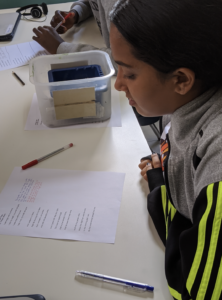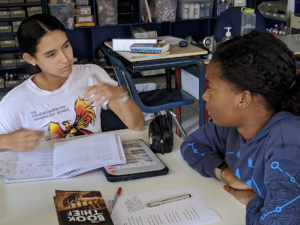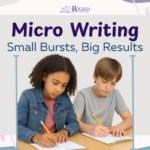Most middle school students are not thrilled to learn that they will be analyzing one poem over three days. (Some teachers might share the same sentiment!) However, I know how many valuable literacy skills can be taught and practiced by really digging into a poem. So they get to do it anyway!
For my middle school students, I chose one of my favorite poems, A Poison Tree, and designed three days of powerful learning that I was determined would NOT bore the students! In the end, not only were they not bored, they actually enjoyed it so much they wanted to do another poem! WIN!
Day 1
I began by asking students to think-pair-share about a time they were really angry. Next, I had them think-pair-share about how they handled that anger and if they would do it differently if it happened again. This was a powerful way to get all the students involved since all middle schoolers like to share their own stories. It also helped the students wrap their minds around the poem we were about to read.
Next, I handed each student a large piece of blank paper. I told them they were about to hear a poem read aloud multiple times. As they listened, I asked the students to draw what they were visualizing (literally or figuratively). I won’t lie – the first two reads through the poem had a majority of the class freaking out! But, with multiple reads and my emphasis of certain words and lines in the poem, all the students were able to create a visual of the poem. After six (yes SIX) reads, I let the students talk with each other about what they heard and what they visualized. Then, I read it four more times so students could add to their drawing.
Finally, I gave the students a copy of the text of the poem to read for themselves. They added to their picture and glued both the poem and the picture in their journal.
Day 2
Today, we analyzed the poem in groups of four, stanza by stanza. Students were given a handout of the poem that had been spaced out to take up an entire page (plenty of room to write on it!). Groups were tasked with discussing stanza one to figure out what was being said. They had three minutes to talk and two minutes to write individually (in blue or black ink) about what the poem meant.
Then, I shared my thinking on that stanza, while also letting them know that there is usually more than one way to analyze a poem. With a red pen, each student then had one minute to write changes in their thinking – things they wanted to add, or new thoughts. I told the students that it was important to continue to grow their thinking, so not having red ink on their paper wasn’t necessarily a good thing! Bonus for today: During the analysis, we inadvertently reviewed all of our lessons on figurative language! #winning
Day 3
On the final day, I taught the students the concept of mood. I defined mood for the students and provided a list of positive and negative mood words. Then we watch the Scholastic video that explained mood, with examples. To apply this new knowledge, we talked about two of the texts we had read earlier in the year. I asked the students what they thought the mood was for those texts and why they thought that.
Next, students applied their knowledge of mood to A Poison Tree and wrote what they thought and why in their journal.
Success!
My students felt success and we all enjoyed our three days with this one poem. What should my next poem be?





